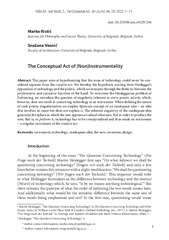The Conceptual Act of (Non)Instrumentality
Чланак у часопису (Објављена верзија)
Метаподаци
Приказ свих података о документуАпстракт
This paper aims at hypothesizing that the issue of technology could never be considered separate from the creative act. We develop the hypothesis starting from Heidegger’s
opposition of technology and the poietic, which we interpret through the dialectic between the
performative and constative function of the hand. To overcome the Heideggerian problem of
Enframing, we introduce the question of singularity inherent in every poietic activity which,
however, does not result in conceiving technology as an instrument. When defining the nature
of such poietic singularization we employ Spinoza’s concept of an inadequate idea – an idea
that involves its cause but does not explain it. The inherent negativity of the inadequate idea
generates the sphere in which the new appears as radical otherness. But in order to produce the
new, that is, to perform it, technology has to be conceptualized and thus made an instrument
– a singular instrument of the creative act.
Кључне речи:
instrument / technology / inadequate idea / the new / invention / designИзвор:
AM Journal of Art and Media Studies, 2022, 29, 1-11Издавач:
- Belgrade: Faculty of Media and Communications, Singidunum University
Финансирање / пројекти:
- Министарство науке, технолошког развоја и иновација Републике Србије, институционално финансирање - 200025 (Универзитет у Београду, Институт за филозофију и друштвену теорију) (RS-MESTD-inst-2020-200025)
Колекције
Институција/група
IFDTTY - JOUR AU - Ristić, Marko AU - Vesnić, Snežana PY - 2022 UR - http://rifdt.instifdt.bg.ac.rs/123456789/2884 AB - This paper aims at hypothesizing that the issue of technology could never be considered separate from the creative act. We develop the hypothesis starting from Heidegger’s opposition of technology and the poietic, which we interpret through the dialectic between the performative and constative function of the hand. To overcome the Heideggerian problem of Enframing, we introduce the question of singularity inherent in every poietic activity which, however, does not result in conceiving technology as an instrument. When defining the nature of such poietic singularization we employ Spinoza’s concept of an inadequate idea – an idea that involves its cause but does not explain it. The inherent negativity of the inadequate idea generates the sphere in which the new appears as radical otherness. But in order to produce the new, that is, to perform it, technology has to be conceptualized and thus made an instrument – a singular instrument of the creative act. PB - Belgrade: Faculty of Media and Communications, Singidunum University T2 - AM Journal of Art and Media Studies T1 - The Conceptual Act of (Non)Instrumentality IS - 29 SP - 1 EP - 11 DO - 10.25038/am.v0i29.536 ER -
@article{
author = "Ristić, Marko and Vesnić, Snežana",
year = "2022",
abstract = "This paper aims at hypothesizing that the issue of technology could never be considered separate from the creative act. We develop the hypothesis starting from Heidegger’s
opposition of technology and the poietic, which we interpret through the dialectic between the
performative and constative function of the hand. To overcome the Heideggerian problem of
Enframing, we introduce the question of singularity inherent in every poietic activity which,
however, does not result in conceiving technology as an instrument. When defining the nature
of such poietic singularization we employ Spinoza’s concept of an inadequate idea – an idea
that involves its cause but does not explain it. The inherent negativity of the inadequate idea
generates the sphere in which the new appears as radical otherness. But in order to produce the
new, that is, to perform it, technology has to be conceptualized and thus made an instrument
– a singular instrument of the creative act.",
publisher = "Belgrade: Faculty of Media and Communications, Singidunum University",
journal = "AM Journal of Art and Media Studies",
title = "The Conceptual Act of (Non)Instrumentality",
number = "29",
pages = "1-11",
doi = "10.25038/am.v0i29.536"
}
Ristić, M.,& Vesnić, S.. (2022). The Conceptual Act of (Non)Instrumentality. in AM Journal of Art and Media Studies Belgrade: Faculty of Media and Communications, Singidunum University.(29), 1-11. https://doi.org/10.25038/am.v0i29.536
Ristić M, Vesnić S. The Conceptual Act of (Non)Instrumentality. in AM Journal of Art and Media Studies. 2022;(29):1-11. doi:10.25038/am.v0i29.536 .
Ristić, Marko, Vesnić, Snežana, "The Conceptual Act of (Non)Instrumentality" in AM Journal of Art and Media Studies, no. 29 (2022):1-11, https://doi.org/10.25038/am.v0i29.536 . .



